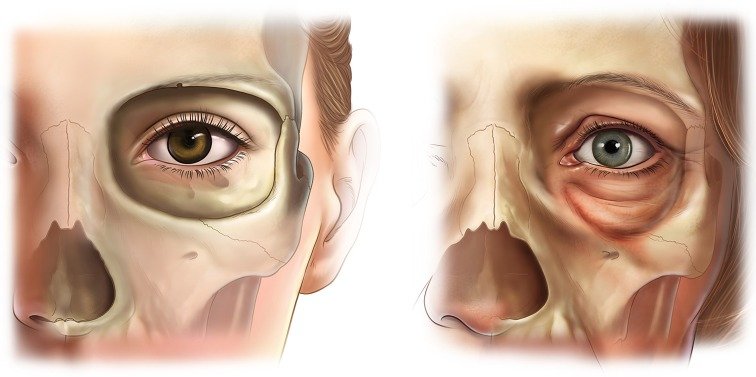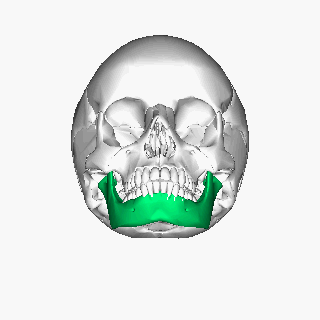https://commons.wikimedia.org/wiki/File:Human_skull_-_animation4.gif, Anatomography, CC BY-SA 2.1 JP <https://creativecommons.org/licenses/by-sa/2.1/jp/deed.en>, via Wikimedia Commons
Deborah Tosline published the book “Skin Remodeling DIY: An Introduction to the Underground World of Do-It-Yourself Skincare” in 2015. Her approach to skincare is based on a scientific background, a love of research, and over 40 years of DIY skincare experience.
Serums, creams, facial masks, facial tools, and med spa treatments focus on improving skin conditions. Healthy, unblemished skin is alluring — but it is not the only method for maintaining our appearance. Facial bone loss is scientifically documented and significantly impacts how we look. The beauty industry does not focus on facial bone loss, despite the fact that it is associated with facial volume loss, skin sagging, wrinkles, and folds. Facial fillers may be used to address volume loss; however, as bones shrink and thin, the continual use of fillers may not be sustainable. Our facial bones provide the foundational architecture for our aesthetic appearance.
Our skull consists of 22 bones held together by cranial sutures — joints or spaces between the bones that contain tough, flexible tissue. The skull supports muscles and tendon attachments and protects our brain, neurovascular structures, and more. There are 14 facial bones with specific anatomical features, such as nasal bones for breathing and the temporomandibular joint (TMJ) for chewing.
https://commons.wikimedia.org/wiki/File:Zygomaticomaxillary_suture_-_animation06.gif, Polygon data is from BodyParts3D, CC BY-SA 2.1 JP <https://creativecommons.org/licenses/by-sa/2.1/jp/deed.en>, via Wikimedia Commons
Facial Skeletal Framework Consists Primarily of:
Maxilla – upper jaw bone
Zygomatic bones – cheekbones, nasal bones, and the orbital bones surrounding the eyes
Mandible – lower jaw bone
The maxilla and zygomatic bones provide midface projection and cheek prominence. The orbital bones impact the shape of the eye sockets and the appearance of the eyes and brow. The mandible provides structure for the lower jaw, jawline definition, and lower facial width.
Facial bones define the contours and symmetry of the face. Their shape, structure, and balance impact facial proportion — and our perceptions of beauty.
Orbital aging. The superomedial and inferolateral aspects of the orbit have the greatest tendency to resorb. This contributes to the stigmata of periorbital aging such as increased prominence of the medial fat pad, elevation of the medial brow, and lengthening of the lid cheek junction. https://pmc.ncbi.nlm.nih.gov/articles/PMC3404279/
The Aging Facial Skeleton
Over time, facial bones undergo significant transformations that change how we look as we age. Skin and muscles that were once supported by a strong bony foundation begin to sag as that foundation shrinks. When facial bones lose volume, the skin sags over the shrinking bone structure.
Bones continually change throughout our lives. This process is known as bone remodeling, it helps to protect bones and metabolically balance the body’s calcium and phosphorus levels. Bone remodeling includes resorption of old or damaged bone and deposition of new bone material. Resorption occurs when the body breaks down tissue and cells. Bone loss occurs when resorption exceeds the deposition of new bone.
The piriform (piriform angle) and the maxilla (maxillary angle) significantly recede with aging, from youth (left) to old age (right) [11], https://pmc.ncbi.nlm.nih.gov/articles/PMC3404279/
Bone Resorption Impacts Facial Structure:
Midface: Resorption of the maxilla results in a flatter midface and deeper nasolabial folds.
Orbital Area: Bone loss causes the eye sockets to enlarge, resulting in loose skin, drooping eyelids, and sunken eyes.
Mandible: Reduction in jawbone volume shrinks the jawline, contributing to jowls, loose skin, and a less defined chin.
Facial bones resorb in a specific and predictable way. Bone shrinkage weakens the skeletal structure, which causes the overlying muscles and skin to sag and fold. It is generally believed that the facial skeleton is dynamic and that the skull continues to expand throughout life. This suggests that facial bone remodeling may be possible throughout life.
Wolff’s Law states that bone adapts or remodels in response to a mechanical load. As the load increases, the spongy bone strengthens to accommodate it. A decrease in load results in bone weakening.
Remodeling Facial Bones
In the past, I published the following articles summarizing facial bone loss and methods to maintain facial bones:
Mewing – 2024
Mewing - a Mandatory Posture for Optimum Health and a Balanced Facial ProfileBone Remodeling – 2024
Deborah Crowley - Facial Bone Remodeling PioneerBone Remodeling – 2021
Face/Skin Remodeling and Looksmaxxing/Skinmaxxing to Improve Facial Bone and Skin HealthBone Remodeling – 2019
Build Facial Bone Strength and Maintain Your Facial Profile and Contours
I continue to proactively maintain my facial profile by implementing facial bone strengthening practices. I practice mewing and nose breathing to maintain my midface bone structure. I eat chewy, hard foods, pursue healthy nutrition, get regular exercise, follow a consistent sleep routine, and manage stress to the best of my ability. I also practice facial exercises (although not as much as I’d like) and bone maintenance exercises.
https://commons.wikimedia.org/wiki/File:Mandible_inferior_animation.gif, Anatomography, CC BY-SA 2.1 JP <https://creativecommons.org/licenses/by-sa/2.1/jp/deed.en>, via Wikimedia Commons
Looksmaxxing
Looksmaxxing is a practice primarily pursued by young men (and folks like me) who want to optimize their health to improve their appearance in all ways. These individuals seek chiseled jaws, striking profiles, strong chins, and prominent brow structures. I enjoy tracking Looksmaxxing trends and incorporating their methods.
I’ve been following Oscar Patel on YouTube recently. Oscar helps people “…improve their looks by fixing their health.” Check out his channel here.
Oscar describes, instructs, and ranks Looksmaxxing techniques and shares before-and-after photos of his and others’ progress.
As a senior DIY facial remodeling hobbyist, I already practice many of Oscar’s suggestions but I’ve also learned some new methods to maintain my facial bone health. Here are some of the techniques that Oscar promotes to maintain (and build) healthy facial bone structure:
The four habits of the myofascial perspective – how we chew, swallow, breathe, and hold our posture impacts our facial profile.
Mewing – continuously holding the tongue suctioned to the roof of the mouth while breathing only through the nose supports the mid-face structure.
Thumb pulling – using the thumbs to push, lift, and widen the cheekbones.
Jawline gum usage– such as Mastik gum, made from natural tree resin. Chewing may strengthen the jawbone and associated muscles. (Check with your dentist if you have TMJ issues.)
Zygomatic facial taping – KT tape is applied to the face and worn while sleeping to disengage muscles, prevent clenching, and promote nose breathing. https://www.youtube.com/shorts/TwvARLwXOnk
https://commons.wikimedia.org/wiki/File:%CE%9C%CE%B1%CF%83%CF%84%CE%AF%CF%87%CE%B1.jpg, Aggelos1357, CC0, via Wikimedia Commons, Mastik gum.
My approach to bone remodeling is similar to my skin remodeling practice. I view the body as adaptable — to a degree. For example, when I practice guitar, the pressure from the steel strings causes my fingertips to become red and sore. Day by day, as I continue to play, the skin thickens and strengthens. Over time, I am able to play longer.
Looksmaxxing is led by a younger crowd — mostly men — who are still growing. They appear to be more malleable. However, it is generally acknowledged that the skull continues to change throughout life.
At age 66, am I too old to practice bone remodeling? IDK — I still feel malleable, changeable and adaptable. What have I got to lose? I pursue facial bone strengthening techniques based on the premise that when a load is applied to my facial bones, they may respond by becoming stronger. Maybe I’ll adapt more slowly, but I believe I’ll adapt.
I will consistently practice facial exercises, bone remodeling exercises, mewing, thumb pulling, zygo taping, and other facial bone remodeling techniques to maintain facial bone mass. If possible, I’ll work to keep my cheeks, nose, and jaw lifted and full — similar to how I made my fingertips tough and strong for the guitar.
If you want more information about DIY skincare, check out your local library, search online, or explore my past blog articles. It would be an honor if you purchased my skincare book.
Take good care of yourselves!
XO, Deborah
This article is intended as general information only and is not a substitute for medical advice, diagnosis, or treatment. No warranties are expressed or implied regarding the effectiveness of the practices described. Products or substances discussed are for educational purposes and not recommendations of the author.
OpenAI. (2025, May 27). ChatGPT (GPT-4.5, o4 model) in collaboration with Deborah Tosline assisted with research and editing support. Retrieved from https://chat.openai.com





